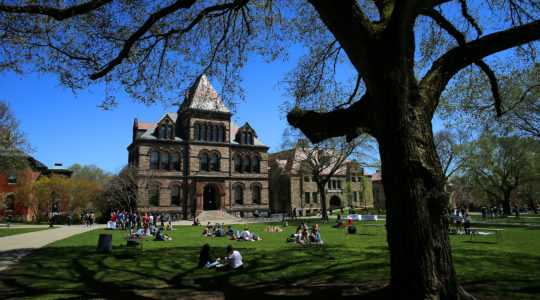MONTICELLO, N.Y. (JTA) — The moment I kicked in the door of the abandoned house in the heart of the Catskills, I felt like I was in an episode of “The Twilight Zone: Borscht Belt edition.”
In some corners it appeared as if the residents were just out for the afternoon. Pictures and tchotchkes adorned the walls. A mezuzah with the parchment still inside was affixed to a doorpost. A working upright piano sat in one corner. Ironing boards were open. Mattresses lay on beds; in one room the beds were still half-made.
But elsewhere, things were in a state of advanced decay. The roof over the kitchen had caved in. The sink was overflowing with rotting leaves. In a bedroom, vines poured in through the window and spread over much of the ceiling. Mold was having its way with the walls.
I had come to the Catskills hoping to get one last look at Kutsher’s, the last of the great Borscht Belt resorts, after hearing the news that its demolition was imminent. For much of the 20th century, Kutsher’s and other Jewish hotels like it helped make the Catskills the summer destination of choice for New York Jews.
But when I reached the mountains a few days later, I found the roads leading to Kutsher’s blocked by chains and sawhorses posted with warnings against trespassing into the hard-hat zone. I tried to make my way on foot, wading through wet, overgrown grass, but three burly construction workers spotted me and I was forced to beat a hasty retreat.
Which is how I found my way into a crumbling bungalow colony at the edge of Kutsher’s 1,500 acres.
Aside from the main house with 10 bedrooms and side building with a dining room and kitchen that I had broken into, there were a handful of bungalows, a pool and a lake. The buildings all were vacant, in varying states of disrepair and overcome by nature.
One room had half a dozen ovens and refrigerators. Opening one fridge, I half expected to find a cold can of Tab. No dice. In the corner of what appeared to be the living room, there was a public telephone. I picked it up. No dial tone.
Most of the bedrooms were disheveled or empty, but in one I found toiletries and a shoeshine kit carefully arranged on the dresser, three drab but clean dresses hanging in the closet, and a shelf filled with unused legal pads and blank paper.
Then I spotted the first clue to who may have lived here.

This photograph, dated August 2001, was affixed to a mirror in one of the bedrooms of the derelict bungalow colony. Nat and Sylvia Goldberg are at far left. The three other couples are identified on the back only as Herman & Eleanor, Milton & Norma and Jack & Charlotte.
Tucked into the mirror was a photograph of four happy-looking elderly couples posing in front of the lake out back now obscured by foliage. Their names were carefully inscribed on the back: Nat & Sylvia, Herman & Eleanor, Milton & Norma, Jack & Charlotte. There was also a date: August 2001.
Who were these people and why did they leave? What purpose did this odd house serve? Were the people in the photo still alive? When was the house last occupied?
This being the age of the Internet, it took less than an hour of sleuthing, a credit card and $3.95 to unravel the mystery of this strange Catskills time capsule.
The simple part was figuring out who lived there. An address label affixed to some shelves in the bedroom with the shoeshine kit read Goldberg. That matched the name on a Jewish National Fund Tree-in-Israel certificate posted on the wall in another room. Along with the photograph I found, I had my target couple: Nat and Sylvia Goldberg.
Combing through online directories and death notices, it didn’t take long to locate family members. Soon I had Nat and Sylvia’s daughter, Judy Viteli, on the line.
She almost cried when I told her where I had been.
“Ah, the kochelein,” she said wistfully.
The what?
“The kochelein,” she said. “It’s a Yiddish word.”
Over the course of several conversations, including one in which we went through old pictures at her kitchen table, Judy and her sister, Paula Goldberg — now 60 and 63, respectively — told me the story of what had transpired half a century ago in that house, why it represented the best years of their lives and how it all came to an end. This is their story.
JTA has documented Jewish history in real-time for over a century. Keep our journalism strong by joining us in supporting independent, award-winning reporting.






